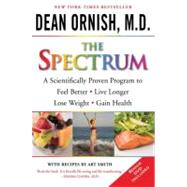The Spectrum
, by ORNISH, DEAN MD- ISBN: 9780345496317 | 0345496310
- Cover: Trade Paper
- Copyright: 12/30/2008
InTHE SPECTRUM, Dr. Ornish shows us how to personalize a way of eating and a way of living based on your own health goals, needs, and preferences. Here's how it works: SinceTHE SPECTRUMis about freedom of choice, there is no diet to get on and no diet to get off. Nothing is forbidden. No guilt, no shame, no pressure.THE SPECTRUMis based on love joy of living, not fear of dying. Feeling better, not denying yourself pleasure. First, determine your health and wellness goals. Do you want to lose weight? Do you have high cholesterol? Is diabetes a problem in your family? Based on your individual needs and goals,THE SPECTRUMhas examples of six individually-tailored lifestyle programs ideally suited for you: lowering cholesterol, losing weight, lowering blood pressure, preventing/reversing diabetes, preventing/reversing certain types of prostate and breast cancer, preventing/reversing heart disease. Each personalized plan inTHE SPECTRUMhas 3 components: Nutrition, Stress Management, and Exercise. The Nutrition Spectrum The Nutrition Spectrum consists of five groups. Group 1 is the healthiest end of the spectrum and Group 5 is the least healthful end. To determine your current place on the Nutrition Spectrum, find the group that contains the foods you tend to eat most of the time. Then, according to your needs, preferences, and goals, decide how far and how quickly you want to move in a more healthful direction. For example, if you typically eat predominantly foods in Group 4 and you want to lower your cholesterol 50 points, begin by incorporating more foods from Groups 2 and 3. If that's sufficient to achieve your goal, great; if not, you can move more towards the healthier end ofTHE SPECTRUMby consuming more foods from Groups 1 and 2. In general, the closer you move towards Group 1, the more benefits you're likely to gain and the more quickly you'll experience them. If you're healthy, you many not need or want to make very many changes at allthe "ounce of prevention." On the other hand, if you are trying to reverse heart disease or diabetes, you'll probably need to make bigger changesthe "pound of cure." The recipes by Art Smith forTHE SPECTRUMare designed so that each base recipe is in Group 1. Depending on your health and wellness goals, each recipe offers healthy variations. For example, the Vegetable Chili recipe is a delicious version of a classic recipe that begins in Group 1 with predominantly plant-based whole foods that are very low in fat, sugar, salt, and calories. Variations listed at the end of the recipe include adding a cup of pitted higher-fat black olives (which moves this recipe to a Group 2 dish) and/or adding one pound of turkey breast sausage to the recipe (which moves this recipe to a Group 4 dish). The Stress Management Spectrum Stress can have a negative impact on just about every part of your body. It can suppress your immune function, cause a heart attack or stroke, increase your risk of cancer, delay wound healing, promote inflammation, cause you to gain weight, impair your memory, cause depression, exacerbate diabetes, and worsen sexual function. Just for starters. Stress also makes you age faster even at a genetic and cellular level. (over) Some people thrive on stress, and it doesn't cause them to get sick. Studies have found that they can turn it on when needed, but they can also turn it off. They have appropriately elevated levels of stress hormones at work during the day, but their stress hormones drop sharply at night. In other words, they can turn it off. In contrast, people who feel chronically stressed and anxious have stress h







